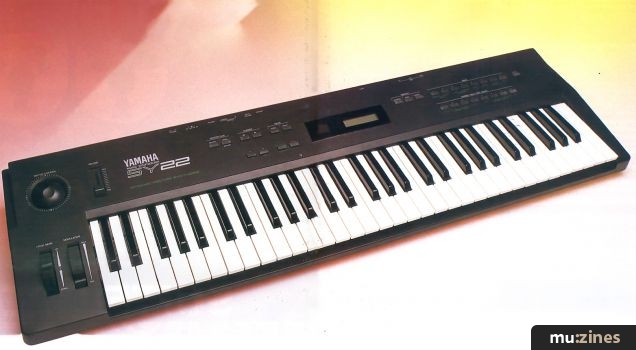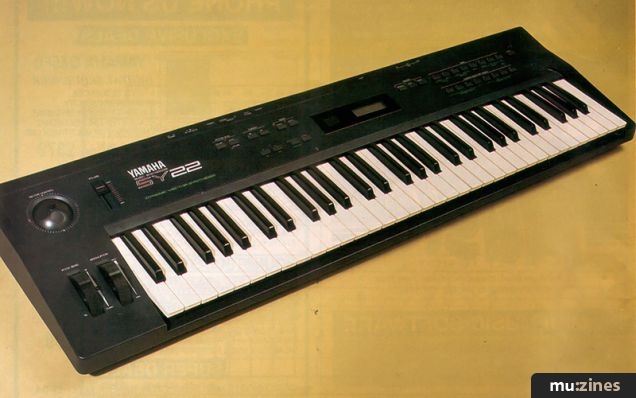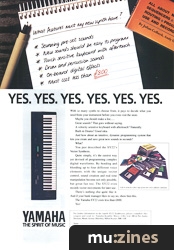Magazine Archive
Home -> Magazines -> Issues -> Articles in this issue -> View
Yamaha SY22 | |
DYNAMIC VECTOR SYNTHESISERArticle from Music Technology, April 1990 | |
Yamaha's new SY22 combines RCM synthesis with elements of the Prophet VS's vector synthesis to give us Dynamic Vector Synthesis. Simon Trask previews the return of the joystick synth.
IT SEEMS THAT Yamaha are wasting no time in following up the release of their flagship SY77 RCM synthesiser with a succession of cheaper variations. But where the TG55 expander and SY55 synth (reviewed MT, March and April respectively) are directly descended from the SY77, somewhere along the way the 77 mated with Sequential's Prophet VS synth and the SY22 was conceived.
"Why the Prophet VS?" you may wonder. Well, older readers may recall that Yamaha bought out the filing Sequential in late '87, a move which allowed them to buy into the American company's technology and expertise. Sequential ceased to exist as a separate entity, and Sequential instruments such as the VS (which first appeared in '86) fell by the wayside. But now at least (at last?) the VS' innovative angle on real time synthesis, namely vector synthesis, lives on in the SY22.
The VS allowed you to mix four waveforms in real time using a front-panel joystick operating on an X/Y axis. These four waveforms were 'located' at the four tips of the axis, and the joystick's position in the X/Y 'field' at any given moment determined the sonic balance of the waveforms. The precise intersection of SY and VS occurs with the four Elements of RCM synthesis, which on the SY22 take the place of the VS' four waveforms - if you're beginning to think you've wandered into a maths lesson by mistake, don't worry, I'm just winding you up. The word 'vector' may have mathematical connotations, but the SY22 is more likely to exercise your hand than your mind - if you can wiggle a joystick, you'll be OK.
No doubt in anticipation of some serious wiggling from SY22 users, Yamaha's vector controller is a cross between a tracker-ball and a joystick, which means you should be able to cross your X with your Y and not end up with sweet FA. There are also slight indentations in the 'ball" to facilitate more subtle fingertip control (perhaps I should rephrase that for our younger viewers...).
Like the SY77, the 22 allows you to combine up to four Elements to make a Voice (of which there are 64 onboard, with a further 64 accessible from a plug-in card). Elements A and C can each consist of a sampled sound, Elements B and D of an FM-synthesised sound - so that, unlike the 77, the 22 doesn't allow you to combine four sampled sounds. On a more positive note, the SY22 retains the 32-note polyphony of its more expensive relative (again divided equally: 16:16 between the FM and sample sections). The 22 is eight-part multitimbral compared to the 77's 16 parts, and implements Multi patches as on the SY77 - however, with the addition that up to all eight parts can be assigned to the same MIDI channel if you want (in this way you could create a four-sample sound by layering two Voices). It also has a five-octave, synth-style keyboard which is sensitive to attack velocity and channel aftertouch.
Unlike the SY77 and SY55, the 22 doesn't have an onboard sequencer, but it does include a 'drumkit* of 61 sampled and, synthesised drum and percussion sounds (collectively specified as sample 127) and a digital effects section offering a choice of 16 effects (hall, room, plate, club, big metal and gated reverbs; delay 1, 2, and 3; doubler; ping pong; panned reflection; early reflection; delay+reverb 1 and 2; and distortion+reverb) with depth control as the only alterable parameter.
The SY22 has a total of 127 samples, excluding those in the drumkit section, and unlike those on the other SYs and the TG55, these are 12-bit. Also unlike its relatives, the 22 doesn't have access to further samples on ROM cards (the only card facility is for loading and saving Voice parameter data) and doesn't have any filters, while its FM synthesis capability is four-operator as opposed to the SY77's six, is limited to one algorithm (two carriers each with one modulator), and provides control over carrier envelopes and feedback amount only - though significantly you do get a choice of 255 preset modulator envelopes which provide a quick means of creating timbral changes in the FM sounds.
The SY22's vector controller allows you to create a continuously shifting mix of the four Elements within a Voice. But it doesn't limit you to live mixes: for each Voice you can record a sequence of up to 50 X/Y coordinate positions of the joystick for level, and another 50 for detune (governing all four Elements at once); in this way, level and pitch changes for the four Elements become an integral part of the Voice. These can either be recorded in real time using the joystick, or in step time by numeric entry via the LCD window: additionally you can get the SY22 to create random level and detune changes which you can then store as part of a Voice if you like the results. You can also loop these vector sequences and alter their speed, while an even more interesting option apparently allows you to use two pairs of MIDI controllers (governing the vector X/Y axis in each case) for external MIDI sequencer control of Element level and detune. Many possibilities suggest themselves here, but I'll refrain from getting too enthusiastic until I've checked this feature out.
In addition you get a choice of eight preset vector sequences which step through a series of sounds within an individual Element; these can be integrated into any Voice. It's a neat feature, but not as flexible as it could have been (ie. you can't create your own sequences).
Yamaha conceived the SY22 as an ideal first instrument for home keyboard players wanting to cross over to the world of synthesisers. On first impressions, gained from a short time with the synth at the company's R&D centre in London, I'd say they've succeeded by deliberately keeping the SY22 relatively straightforward both operationally and functionally. At the same time it appears to be sufficiently sophisticated sonically to attract synth players - who, of course, value qualities like straightforward operation, too. Vector synthesis, meanwhile, looks as if it could be a gimmick in some hands but a considerably more interesting prospect in others.
Yamaha have been criticised in the past for the complexity both of FM synthesis and of the way FM synthesis has been presented as a programming system. With their new flagship synth they have to some extent eased the latter, but not compromised on the sophistication and complexity of the instrument as a whole.
In contrast, the SY22 looks to be a synth for those musicians who don't want to deal with undue complexity, while offering enough to intrigue the inquisitive.
Price £799
(Contact Details)
Also featuring gear in this article
Publisher: Music Technology - Music Maker Publications (UK), Future Publishing.
The current copyright owner/s of this content may differ from the originally published copyright notice.
More details on copyright ownership...
Review by Simon Trask
Help Support The Things You Love
mu:zines is the result of thousands of hours of effort, and will require many thousands more going forward to reach our goals of getting all this content online.
If you value this resource, you can support this project - it really helps!
Donations for September 2025
Issues donated this month: 0
New issues that have been donated or scanned for us this month.
Funds donated this month: £0.00
All donations and support are gratefully appreciated - thank you.
Magazines Needed - Can You Help?
Do you have any of these magazine issues?
If so, and you can donate, lend or scan them to help complete our archive, please get in touch via the Contribute page - thanks!





